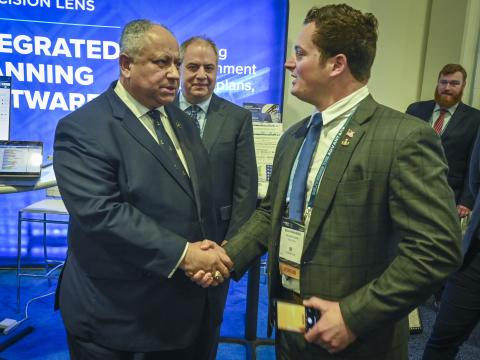Core Backbone Key to Meeting Federal IPv6 Mandate
Focus must go beyond the deadline and look to future capabilities.
The transition to Internet protocol version 6 (IPv6) is not about the protocol but what that protocol will enable. The first step is to have a core backbone in place, and from there, “things start getting exciting and interesting,” relates Dr. John W. McManus, deputy chief information officer and chief technology officer, U.S. Commerce Department.
Speaking as part of a recent AFCEA International conference titled “IPv6 Tech Forum: From Mandate to Mission,” McManus explained that IPv6 substantially increases the number of addresses available for networked devices, enables new services and adds point-to-point built-in security functions. An Office of Management and Budget (OMB) mandate requires that federal agencies upgrade their network backbones to IPv6 by July 1, 2008.
“The IPv6 mandate is critical to making sure the core networks move in an appropriate timeframe and that they move pretty much together so that we can have the level of interoperability and cohesion that we need,” McManus declared. The big opportunity of IPv6 isn’t teaching people about bigger headers and more addresses and built-in security, he said. It is about determining how this new set of capabilities can make people’s lives better.
End-user adoption of IPv6 will come not from access to “killer applications,” McManus suggested, but from “killer devices.” The converged handheld device will start to push mobility, and that will press IPv6 beyond the core network, he predicted. The network has to maintain pace and stay ahead of evolving requirements, and IPv6 is part of future-proofing your network, McManus added.
As part of transitioning the 105 agencies and bureaus affected by the mandate, McManus said, everyone needs a shared view of the definition of success. The OMB and the federal community decided to keep the definition simple. Agencies must be able to accept traffic from an external network, pull it through the core network and distribute it to a subnetwork.
The deadlines for the core network are tight ones, and “if we want to declare victory in June, we have to be done testing in March or April and have the system ready to go,” McManus warned. A large number of agencies are making good progress toward meeting the deadline. Those that are being successful at transitioning are making IPv6 part of their normal network evolution. They are not doing it because of the IPv6 mandate, but to evolve their networks, decrease latency, bring on increased bandwidth and provide new services such as more mobility and security, he contended.
IPv6 is not a separate, unique event. “There are a lot of people who think this is very similar to Y2K. Boom! We will hit that day; everything is going to be done; and we will be good—and, no, its not,” McManus related. “This is not a sprint to 2008. Network evolution is ongoing, and this is part of learning the marathon.”
He continued that the mandate moves the right part of the network at the right time. It is forcing the transition to only those elements that are common to allow communications, and it is not forcing IPv6 out past the core backbone. “Recognize that we will run in a dual environment for a long time,” he explained, suggesting that a period of transition ranging from four to 20 years is possible. Transition planning must address the need to communicate with emerging devices, to move applications and to support existing infrastructure. “Thinking through how do we get this deployed and how the networks can coexist is critical,” he stated.
Also speaking at the conference was David Wennergren, deputy assistant secretary of defense for information management and technology and deputy chief information officer, Defense Department, who related that IPv6 is helping the move to the enterprise world by making the technological changes that make a difference. IPv6 “is a critical enabler” in this area, he offered.
The Defense Department team that has been working the IPv6 issue has brought together the plans and priorities of the military departments and defense agencies, working out of the Defense Information Systems Agency with staff from the Office of the Secretary of Defense and partnering with the National Institute of Standards and Technology. “They are working hard to make this transition a wonderful example of how you can work as an enterprise,” Wennergren emphasized.
The one-day event included panels on security, operability and the uses of IPv6; applicable deployments and initiatives seen in government; and IPv6 applications in use. Podcasts of both McManus’ and Wennergren’s speeches are available at www.afcea.org/signal/podcasts.asp.



